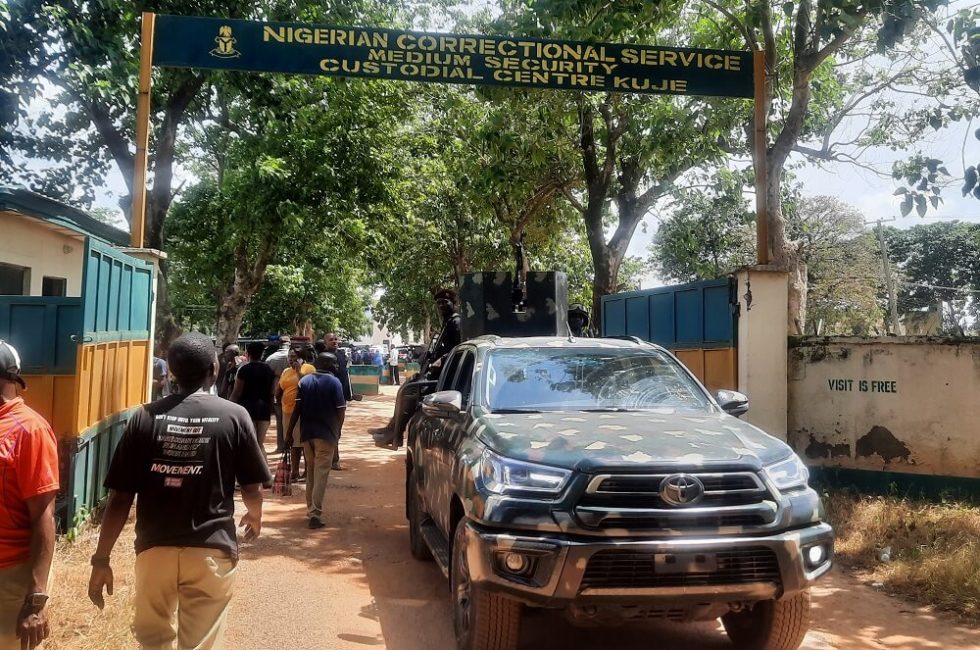Kuje Jailbreak: Officials, Expert Explain How Defective Physical Security, Internal Collusion, Helped Terrorists Overrun Prison
The buffer zone of the Kuje Medium Correctional Service, Abuja is the designated area between the facility and its end wall – a red zone for non-staff members which was flagrantly breached by terrorists in a recent attack.
Members of the Islamic State of West African Province (ISWAP), encountered mild resistance in the night of July 5. They crashed through the main and the rear entrances, shooting their way in with no security barriers to deter them.
Advertisement
Officials in Kuje Corrections who discussed with THE WHISTLER off-the-record have given an insight into why terrorists met no resistance.
They broke through the rear wall of the facility easily. It was a slender wall of blocks and cement instead of the recommended four-inch-thick reinforced concrete wall or precast.
The wall on the outer perimeter is only about 6-7 feet high as against recommended height of 8-15 feet.
Visitors have one-stop access to the facility after scaling the first perimeter, unlike standard practice where prison buildings should have outer and inner fence lines with a clear zone of at least 10 yards in between.
Advertisement
The main road leading to the facility is surrounded by overgrown trees; thick bushy areas on the left and a fence demarcating a residential area on the right side before the gate.
Operatives manning the three bullet-proof towers stationed on the inner perimeter of the facility cannot have a clear view for surveillance even during daytime. At night, they do not have any view at all.
Failed System
Officials said the ISWAP invasion at about 10 pm into the prison was helped by insider collusion, but a lack of functional security infrastructure was to blame.
There was no standby generating set to illuminate the thick bushy surroundings at night as well as absence of other security necessities.
Advertisement
The facility is not well fenced and has no functional CCTV because the ones there are not working.
The 560-capacity facility, commissioned in 1989, was primarily meant for political detainees and related offenders, a probable reason why the government did not see the need to upgrade the security infrastructure around it.
Now the facility is being used to keep hardened criminals and terrorists due to the rise of insecurity in the country.
“This facility was originally a Medium Prison but when insecurity increased, they verbally upgraded it to Maximum Prison, having to keep all categories of criminals here. But the government failed to upgrade the prison alongside by providing an underground cell and other needed facilities,” an official said.
Trajectory of Attacks
The assailants used explosives, Rocket Propelled Grenades (RPGs) and General-Purpose Machine Guns (GPMGs) to break down the frail wall perimeter.
Advertisement
After destroying the walls, they overwhelmed security operatives with the first blast of dynamite, and made a triumphant entry.
At least eight shallow bullet holes were sighted on the walls holding the green-painted semi-burglary gate that leads into the building.
“When they realised they couldn’t destroy the main gate and walls of the building because they were built to resist such forces, they used RPG to detach the gate from the walls, destroying the whole place and that was how they gained entrance into the cells.
“They couldn’t have done all that without detailed intelligence. This could either be from an internal person or someone in one of the security agencies,” an official noted.
The authorities said 879 inmates and at least 60 Boko Haram members escaped during the attack, but said 443 inmates were recaptured as of July 5.
Nine days after the incident, the authorities are yet to issue an official update on the number of recaptured inmates, but the police and the National Drug Law Enforcement Agency (NDLEA) have reported the arrest of three BH inmates.
Checks by THE WHISTLER showed that the country has witnessed at least 15 jailbreaks since 2010 while a total of 7,800 inmates escaped the affected facilities during the attacks. Not all were recaptured.
A security expert and Founder, Beacon Consultant, Kabir Adamu, said such an incident was a failure of the system including external and internal factors.
He highlighted internal factors to include: congestion, poor prison management practices including allowing inmates to own and operate telephone lines, grievances among prison staff, poor access control and defective physical security.
External factors also include the existence of non-state actors who are determined to attack these centres, the lack of support from host communities and others.
How To Improve Security
Adamu advised that President Muhammadu Buhari issued a directive to the coordinating elements within the national security sector to go after the perpetrators and bring their corpses or them alive.
He urged the president to instruct all security Ministries Departments and Agencies (MDAs), and the Ministry of Transportation to immediately ensure all vehicles and motorcycles are registered and their owners known and documented.
“No non-registered vehicle or motorbike should be allowed anywhere.
“He should ensure that the security arrangement in the custodial centres has concentric circles of security that have the elements to detect, deny, delay and respond,” he said.



